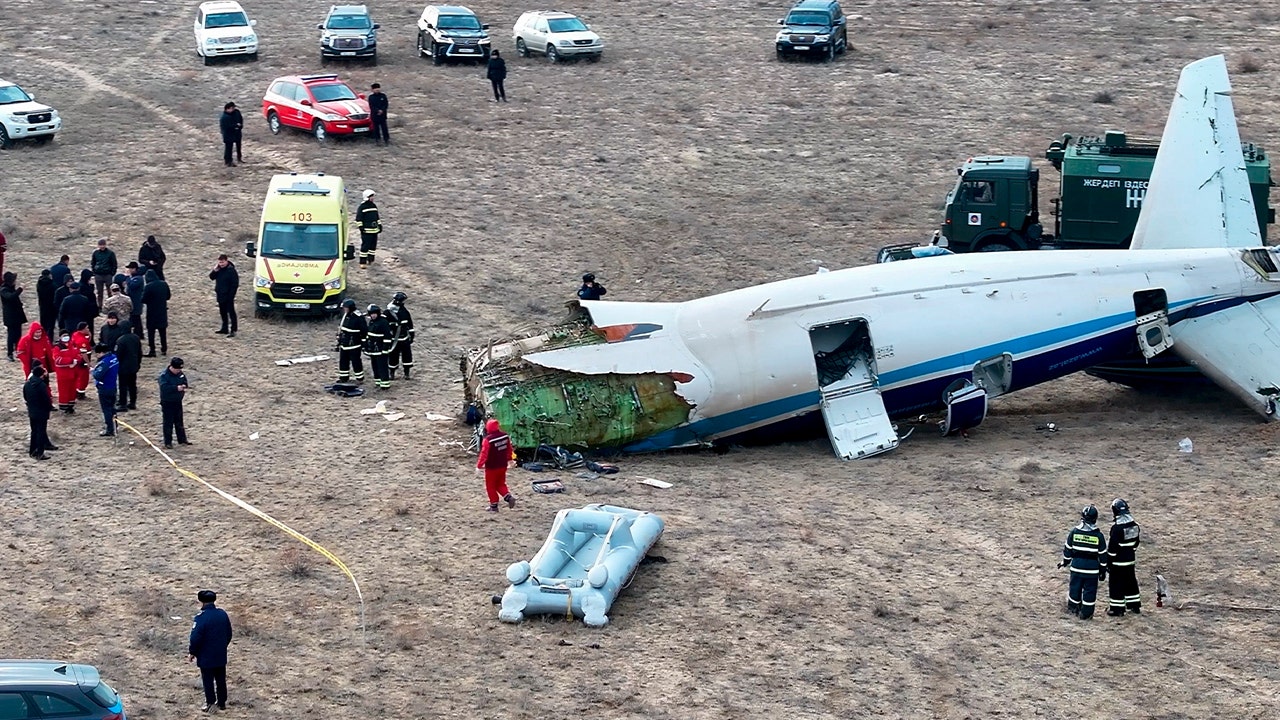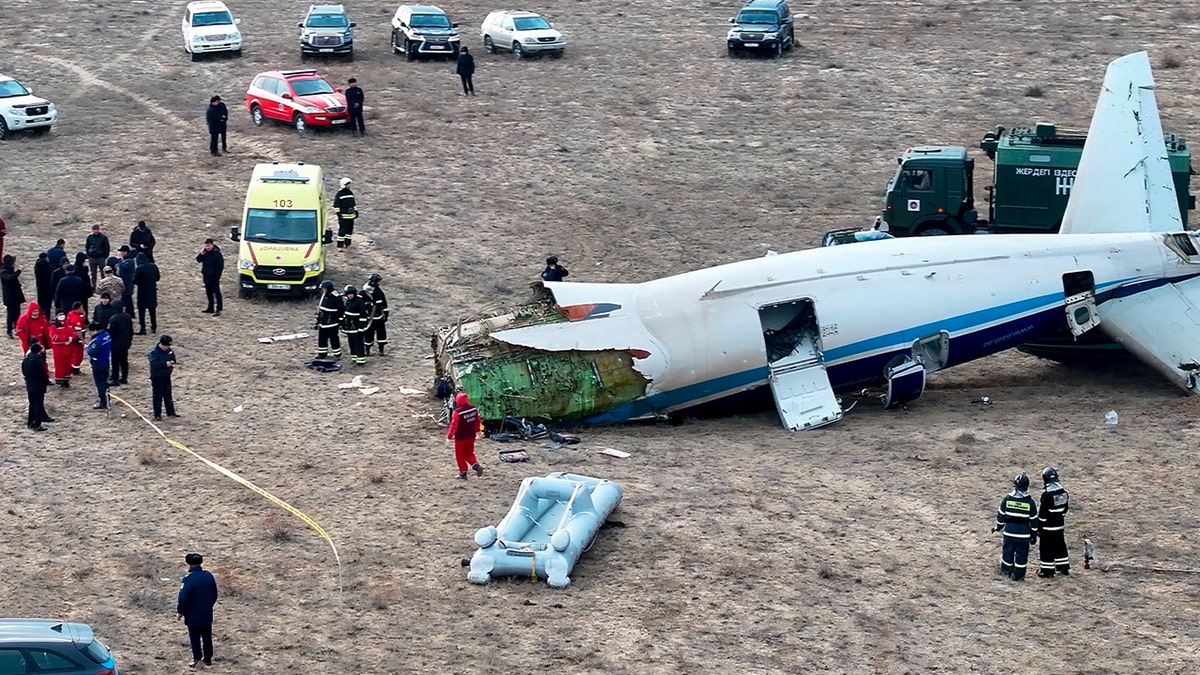World
Video: Deadly Shooting in Auckland Before Women’s World Cup

new video loaded: Deadly Shooting in Auckland Before Women’s World Cup
transcript
transcript
Deadly Shooting in Auckland Before Women’s World Cup
Prime Minister Chris Hipkins of New Zealand said that there was no national security risk after the shooting and that the games would proceed as planned.
-
This morning at 7:23 a.m., a witness called police to report a man with a gun, shooting in central Auckland at a building on lower Queen Street. At 7:34 a.m., police arrived on the scene, and the Armed Offenders Squad arrived there four minutes later. The offender was armed with a pump-action shotgun. He moved through the building site, discharging the firearm as he went. Upon reaching the upper levels of the building, the man contained himself in an elevator. Shots were fired, and he was located a short time later. The assessment from officials is that there is no national security risk. There is no change to New Zealand’s national security threat level. Clearly, with the FIFA World Cup kicking off this evening, there are a lot of eyes on Auckland. The government has spoken to FIFA organisers this morning, and the tournament will proceed as planned. I want to reiterate that there is no wider national security threat. This appears to be the actions of one individual.
Recent episodes in Asia Pacific

World
Five journalists killed in Israeli strike near Gaza hospital

Journalists from Al-Quds Today were covering events at al-Awda Hospital when their vehicle was struck.
Five journalists have been killed in an Israeli strike in the vicinity of a hospital in central Gaza, according to Palestinian authorities and media reports.
The journalists from the Al-Quds Today channel were covering events near al-Awda Hospital, located in the Nuseirat refugee camp, when their broadcasting van was hit by an Israeli air strike, Al Jazeera’s Anas al-Sharif reported early on Thursday morning.
Footage from the scene circulating on social media shows a vehicle engulfed in flames.
A screenshot taken from a video of the white-coloured van shows the word “press” in large red lettering across the back of the vehicle.
The deceased journalists have been named as Fadi Hassouna, Ibrahim al-Sheikh Ali, Mohammed al-Ladah, Faisal Abu al-Qumsan and Ayman al-Jadi.
Al Jazeera’s Anas al-Sharif said that Ayman al-Jadi had been waiting for his wife in front of the hospital while she was in labour to give birth to their first child.
Breaking: Five journalists lost their lives after their vehicle was incinerated in an Israeli airstrike targeting the broadcasting van of “Al-Quds Today” channel while covering events near Al-Awda Hospital in the Nuseirat refugee camp, central Gaza Strip. pic.twitter.com/oiAmxgZwO5
— أنس الشريف Anas Al-Sharif (@AnasAlSharif0) December 26, 2024
Civil defence teams retrieved the bodies of the victims and extinguished a fire at the scene, the Quds News Network said.
There was no immediate comment from Israeli authorities.
The Committee to Protect Journalists (CPJ) earlier this month condemned Israel’s killing of four Palestinian journalists in the space of a week, calling on the international community to hold the country accountable for its attacks against the media.
At least 141 journalists have been killed in Israel’s war in Gaza since October 7, 2023, according to the CPJ.
World
Consejos para disfrutar de las celebraciones de fin de año, sin estrés
NUEVA YORK (AP) — Todos conocemos los factores de estrés: obligaciones sociales, rencillas familiares, divisiones políticas, estrés financiero y el deseo de mantenerse alegre y generoso todo el tiempo.
Así que aquí va un recordatorio sobre cómo desterrar a tu perfeccionista interior y disfrutar verdaderamente de la temporada festiva:
“Realmente ayuda dejar de lado algunos de los ‘deberías’”, dice Lynn F. Bufka, jefa de práctica de la Asociación Estadounidense de Psicología. “Decide cuál es la cosa que más importa, y las cosas que te brindan más alegría, y suelta las demás”.
Las tradiciones pueden cambiar y evolucionar, y cuanto más flexibles sean las cosas, más fácil será para todos, dice Bufka.
“Concentra tu energía en crear un espacio cálido para que las personas que amas se reúnan y relajen, se pongan al día y celebren unos a otros. Eso es literalmente todo lo que importa”, concuerda Lauren Iannotti, editora en jefe de Real Simple.
Algunos consejos:
Concéntrate en lo que te hace feliz
Podrías decidir que la conversación es tu objetivo principal y no preocuparte en absoluto por la decoración, dice Bufka. O si la decoración de la mesa es lo que amas, invierte tu energía allí y no te preocupes tanto por otros aspectos.
“Idealmente, debería tratarse de enfocarse en el amor, y eso no significa lo mismo para todos”, dice Bufka.
Permite que otros hagan las cosas por ti.
“La gente quiere ayudar, ¡déjalos!”, dice Iannotti. “Si no te ENCANTA cocinar todas esas guarniciones, o tienes poco tiempo, no hay ninguna vergüenza en aceptar que tu hermana haga el relleno. O busca ayuda de los profesionales: apoya a un restaurante local haciendo un pedido de catering”.
Otra opción es que “cada uno traiga un plato distintivo”, dice Ianotti. “Ahorrarás tiempo y dinero en la preparación y la cocina y tus invitados podrán mostrar sus habilidades”.
Darte permiso para tomar atajos
“Está bien si la casa está un poco desordenada o si la cena se sirve unos minutos tarde”, dice Iannotti. “Si las personas que has invitado están más interesadas en evaluar tu desempeño que en pasar un buen rato, pueden discutirlo con su terapeuta”. (Por cierto, no lo están, añade ella).
Y no dudes en dejar que la gente se sirva por sí misma, cuando sea posible. “Si no tienes tiempo para jugar a ser el barman, crea una bebida insignia con anticipación que puedas servir a todos tus invitados. También puedes simplemente dejar algunos mezcladores para que los invitados se sirvan y hagan sus propias creaciones”, sugiere Caroline Utz, directora editorial y de estrategia en The Spruce.
Está bien tener tiempo a solas
Las cosas funcionarán lo suficientemente bien si no lo supervisas todo, así que cuídate. Tómate pausas o caminatas si eso te ayuda a mantenerte centrado.
“Aunque el mindfulness se está convirtiendo en un término demasiado utilizado en la sociedad actual, hay algo valioso que podemos tomar de esto y aplicar a la temporada de fin de año”, dice Brook Choulet, psiquiatra deportiva y de rendimiento de concierge y fundadora de Choulet Performance Psychiatry.
Ella recomienda “programar microdescansos intencionales” para hacer algo que disfrutes.
“Por ejemplo, podrías programar una llamada telefónica con un amigo de otro estado, tomar un paseo de 15 minutos al aire libre, o incluso ajustar el temporizador y tomar un baño de 15 minutos sin interrupciones”, dijo.
Espera algo de discordia y no te alarmes por ello
“Si te preocupa la polarización y entrar en conversaciones incómodas, intenta pensar en maneras en que puedas terminar una conversación o cambiarla de dirección”, dice Bufka.
Ella recomienda preparar algunas frases de antemano para ayudar a terminar la conversación o cambiarla de dirección.
En resumen, tener la intención de una temporada festiva menos perfecta puede ser justo lo que necesitas.
___
Katherine Roth cubre temas de vida y estilo y otros temas para The Associated Press desde Nueva York.
___
Esta historia fue traducida del inglés por un editor de AP con la ayuda de una herramienta de inteligencia artificial generativa.
World
Azerbaijan Airlines plane headed to Russia crashes hundreds of miles off course, dozens feared dead

Dozens of passengers are feared dead after an Azerbaijan Airlines flight crashed near the city of Aktau in Kazakhstan on Wednesday, reports say.
The Embraer 190 passenger jet flying from Azerbaijan to Russia had 62 passengers and five crew on board, Kazakh authorities announced, saying 32 survivors had been rescued.
Flight J2-8243 had flown hundreds of miles off its scheduled route to crash on the opposite shore of the Caspian Sea. Officials did not immediately explain why it had crossed the sea, but the crash came shortly after drone strikes hit southern Russia. Drone activity has shut airports in the area in the past and the nearest Russian airport on the plane’s flight path was closed on Wednesday morning.
Russia’s aviation watchdog, meanwhile, said it was an emergency that may have been caused by a bird strike.
MORE THAN 30 DEAD IN BRAZIL BUS AND TRUCK COLLISION
In this photo taken from a video released by the administration of Mangystau region, the wreckage of Azerbaijan Airlines Embraer 190 lies on the ground near the airport of Aktau, Kazakhstan, Wednesday, Dec. 25, 2024. (The Administration of Mangystau Region/AP Photo)
Those aboard the plane included 42 Azerbaijani citizens, 16 Russian nationals, six Kazakhstani and three Kyrgyzstani citizens, according to Kazakhstani officials.
Russian news agency Interfax reported that both pilots died in the crash, citing a preliminary assessment by emergency workers at the scene. The news agency also quoted medical workers who stated that four bodies had been recovered from the crash so far.
A total of 29 survivors, including two children, have been hospitalized, the ministry told Russia’s state news agency, RIA Novosti, the Associated Press reported. Many passengers have yet to be accounted for.
MALAYSIA AGREES TO RESUME ‘NO FIND, NO FEE’ HUNT FOR FLIGHT MH370, 10 YEARS AFTER PLANE DISAPPEARED

More than 30 are feared dead following the crash near the Kazakhstani city of Aktau. (Azamat Sarsenbayev/AP Photo)
Video of the crash showed the plane descending rapidly before bursting into flames as it hit the seashore, and thick black smoke then rising, Reuters reported. Bloodied and bruised passengers could be seen stumbling from a piece of the fuselage that had remained intact.
Azerbaijani President Ilham Aliyev, who had been traveling to Russia, returned to Azerbaijan upon hearing news of the crash, the president’s press service said. Aliyev was due to attend an informal meeting of leaders of the Commonwealth of Independent States, a bloc of former Soviet countries founded after the collapse of the Soviet Union, in St. Petersburg.

Emergency crews at the site of the Azerbaijani airliner crash on Dec. 25, 2024. (Azamat Sarsenbayev/AP Photo)
Aliyev expressed his condolences to the families of the victims in a statement on social media.
“It is with deep sadness that I express my condolences to the families of the victims and wish a speedy recovery to those injured,” he wrote.
He also signed a decree declaring Dec. 26 a day of mourning in Azerbaijan.

The plane was en route from the Azerbaijani capital of Baku to the Russian city of Grozny in the North Caucasus, the Associated Press reports. (The Administration of Mangystau Region/AP Photo)
In a statement, Azerbaijan Airlines said it would keep members of the public updated and changed its social media banners to solid black.
“We ask God for mercy on the passengers and crew members who lost their lives,” a translated statement on X said. “Their pain is our pain. We wish a speedy recovery to those injured.”
Reuters and the Associated Press contributed to this report.
-
/cdn.vox-cdn.com/uploads/chorus_asset/file/24924653/236780_Google_AntiTrust_Trial_Custom_Art_CVirginia__0003_1.png)
/cdn.vox-cdn.com/uploads/chorus_asset/file/24924653/236780_Google_AntiTrust_Trial_Custom_Art_CVirginia__0003_1.png) Technology5 days ago
Technology5 days agoGoogle’s counteroffer to the government trying to break it up is unbundling Android apps
-

 News6 days ago
News6 days agoNovo Nordisk shares tumble as weight-loss drug trial data disappoints
-

 Politics6 days ago
Politics6 days agoIllegal immigrant sexually abused child in the U.S. after being removed from the country five times
-

 Entertainment6 days ago
Entertainment6 days ago'It's a little holiday gift': Inside the Weeknd's free Santa Monica show for his biggest fans
-

 Lifestyle6 days ago
Lifestyle6 days agoThink you can't dance? Get up and try these tips in our comic. We dare you!
-

 Technology1 week ago
Technology1 week agoFox News AI Newsletter: OpenAI responds to Elon Musk's lawsuit
-
/cdn.vox-cdn.com/uploads/chorus_asset/file/25672934/Metaphor_Key_Art_Horizontal.png)
/cdn.vox-cdn.com/uploads/chorus_asset/file/25672934/Metaphor_Key_Art_Horizontal.png) Technology1 day ago
Technology1 day agoThere’s a reason Metaphor: ReFantanzio’s battle music sounds as cool as it does
-

 News2 days ago
News2 days agoFrance’s new premier selects Eric Lombard as finance minister



















